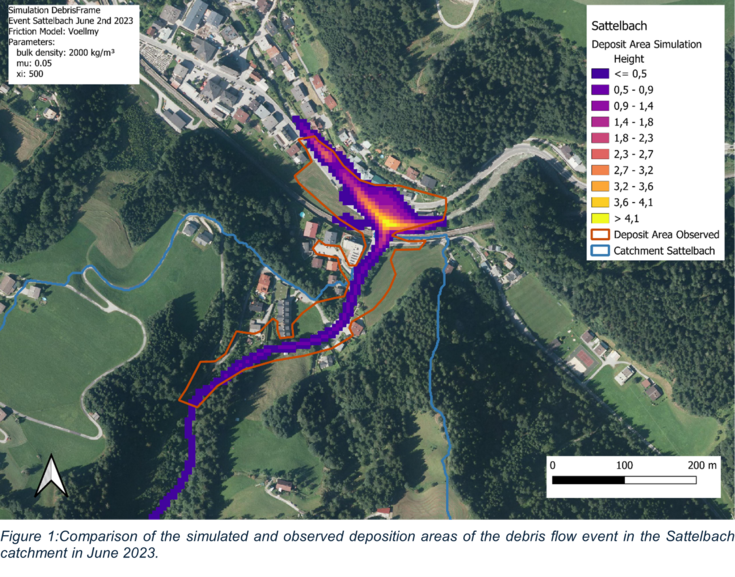Development and testing of an open-source debris-flow simulation tool for engineering and scientific applications
Supervisor: Roland KAITNA
Project assigned to: Julian LAHRSSEN
Debris flows are gravity-driven masses of poorly sorted and water saturated sediments whose dynamics are strongly influenced by the material composition. Large debris flows (109 m³) can release more than 1016 J of potential energy (Iverson, 1997), which is why they have great impact on objects they encounter (e.g. buildings, infrastructure, etc.). Climate change is expected to alter the hydro-meteorological trigger conditions for debris flows in the Alps with a trend to an extension of the debris flow season from summer into spring (Kaitna et al., 2023). Additionally, due to glacier retreat, thawing permafrost and an increase of sediment production by physical weathering, a higher availability of sediment can be expected in high-alpine regions (Jacquemart et al., 2024)
Simulation tools are necessary to delineate hazard zones and develop adaptation strategies in order to protect life and property. Currently, a free, user-friendly and well-documented simulation tool specifically designed for applications in the Austrian Alps is missing. On the basis of the existing avalanche simulation model AvaFrame (Oesterle et al., 2025), the research project “DebrisFrame” aims to develop a framework for debris-flow simulation based on a shallow-water continuum approach, embedded in a QGIS environment.
To solve the underlying equations the unknown friction term in the momentum balance equation is replaced with a constitutive relationship that describes the behavior of deforming matter (Kamali Zarch et al., 2025; Trujillo-Vela et al., 2022). Many studies have dealt with constitutive relationships, but currently no universal friction law matches both the fluid and solid phases under all circumstances (Iverson, 1997; Kamali Zarch et al., 2025; Whorton et al., 2025). Another topic is predicting initial conditions of a debris-flow process to be represented in a numerical model. Common approaches use either a block-release or an input hydrograph as starting condition. Studies have shown that the input hydrograph significantly impacts the model outcome (Mitchell et al., 2022).
Despite the development and programming of specific debris-flow modules, the doctoral thesis focuses on the testing and calibration of the simulation tool under difficult conditions as in practice only a limited amount of information about debris-flow events and the related boundary conditions are available. Using back-calculation of observed events, knowledge about the influence of variable input data, constitutive laws and boundary conditions on the model outcome, specifically regarding hazard zone mapping, should be gained.
During this doctoral thesis following preliminary research questions should be covered:
- What are the main mechanisms in the numerical model that drive debris-flow propagation and how do they affect the outcome of the DebrisFrame model?
- How do the underlying constitutive laws influence the outcome of the simulation? Are there statements that can be made about choosing the proper model under certain conditions?
- Given variable input data, is it possible to estimate uncertainties, particularly regarding hazard zone mapping?
- What are the limitations of the current model when it comes to forecasting debris flows, and what measures can be taken to improve it?
To answer the research questions, I will conduct numerical simulations using the “DebrisFrame” tool. First, sensitivity analyses will be performed to identify the main mechanisms driving debris-flow propagation and evaluate their influence on model outcomes. Then, different constitutive laws will be implemented and compared to investigate their impact on the simulation results and provide recommendations for selecting an appropriate model under specific conditions. To estimate uncertainties, particularly regarding hazard zone mapping, stochastic approaches and scenario analyses will be applied while taking variable input data into account. Finally, I will evaluate the limitations of the current model through validation with real event data and propose potential improvements, such as integrating additional physical processes or refining input data.

Figure 1:Comparison of the simulated and observed deposition areas of the debris flow event in the Sattelbach catchment in June 2023.
References
Iverson, R. M. (1997). The physics of debris flows. Reviews of Geophysics, 35(3), 245–296. doi.org/10.1029/97RG00426
Jacquemart, M., Weber, S., Chiarle, M., Chmiel, M., Cicoira, A., Corona, C., Eckert, N., Gaume, J., Giacona, F., Hirschberg, J., Kaitna, R., Magnin, F., Mayer, S., Moos, C., Van Herwijnen, A., & Stoffel, M. (2024). Detecting the impact of climate change on alpine mass movements in observational records from the European Alps. Earth-Science Reviews, 258, 104886. doi.org/10.1016/j.earscirev.2024.104886
Kaitna, R., Prenner, D., Switanek, M., Maraun, D., Stoffel, M., & Hrachowitz, M. (2023). Changes of hydro-meteorological trigger conditions for debris flows in a future alpine climate. Science of The Total Environment, 872, 162227. doi.org/10.1016/j.scitotenv.2023.162227
Kamali Zarch, M., Zhang, L., Haeri, S. M., & He, J. (2025). Classic, modern, and physics-based rheological laws for geophysical granular flows in a landslide hazard chain. Earth-Science Reviews, 269, 105204. doi.org/10.1016/j.earscirev.2025.105204
Mitchell, A., Zubrycky, S., McDougall, S., Aaron, J., Jacquemart, M., Hübl, J., Kaitna, R., & Graf, C. (2022). Variable hydrograph inputs for a numerical debris-flow runout model. Natural Hazards and Earth System Sciences, 22(5), 1627–1654. doi.org/10.5194/nhess-22-1627-2022
Oesterle, F., Wirbel, A., Fischer, J.-T., Huber, A., & Spannring, P. (2025). avaframe/AvaFrame: 2.0a2 (Version 2.0a1) [Computer software]. Zenodo. doi.org/10.5281/ZENODO.17202638
Trujillo-Vela, M. G., Ramos-Cañón, A. M., Escobar-Vargas, J. A., & Galindo-Torres, S. A. (2022). An overview of debris-flow mathematical modelling. Earth-Science Reviews, 232, 104135. doi.org/10.1016/j.earscirev.2022.104135
Whorton, J., Jones, T. J., & Wilson, L. (2025). Mudflow rheology: A review and analysis for Earth and planetary science disciplines. Earth-Science Reviews, 270, 105226. doi.org/10.1016/j.earscirev.2025.105226
